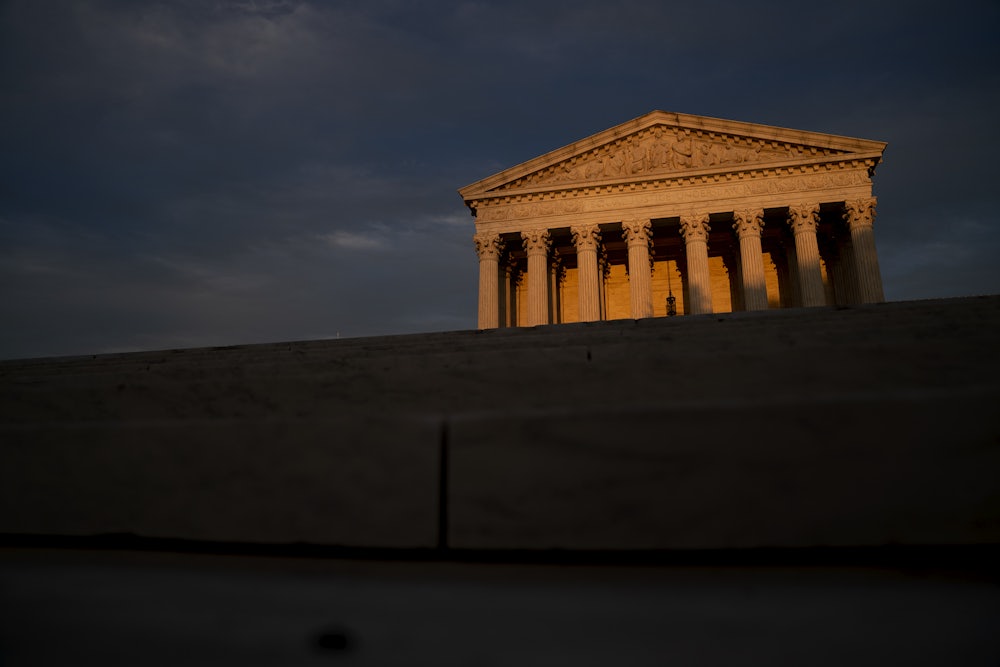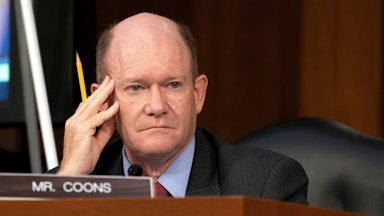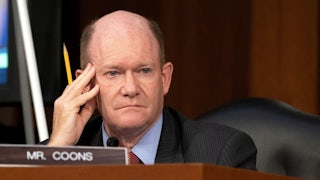President Joe Biden’s commission on Supreme Court reform issued a preliminary report on Thursday calling for the high court’s replacement by a supreme revolutionary tribunal modeled after the Committee of Public Safety in revolutionary France. The tribunal, according to the commission, should be empowered to impose socialism upon the U.S. economy, mandate critical race theory in schools, and spread cancel culture to every corner of American society.
Just kidding. In reality, Biden’s commission on Supreme Court reform appears to be heading in a far more milquetoast direction. In a series of draft findings released on Thursday, the commission signaled that it was divided on the issue of packing the Supreme Court—a solution favored by many to address the court’s perceived illegitimacy—and offered some strong critiques of proposals to do so. At the same time, the draft report revealed that the commission has a substantial blind spot: It failed to address the confirmation process itself, how it contributes to the problems surrounding the court, or how that process could be improved or fixed.
A final report is due in the coming months. Until then, the commission has laid out its preliminary findings in 200 pages of “discussion materials” that are posted on its website. Those materials are divided into five subject-matter sections: the “genesis of the reform debate,” the Supreme Court’s size and membership, the benefits and drawbacks of term limits, the court’s “role in the constitutional system,” and the court’s case-selection and docket-management practices. Taken together, it’s one of the most comprehensive reviews of the Supreme Court’s structure and practices by another branch of government in living memory.
The commission’s origins spring from growing liberal frustration with the court’s ideological shifts since Antonin Scalia’s death in 2016—and Senate Republicans’ decision to deny an up-or-down vote to Barack Obama’s nominee to replace him. That cynical blockade enabled Donald Trump, who incited a mob to attack Congress earlier this year, to fill that seat with a nominee of his own, followed by two other vacancies over the next four years. The effect was as infuriating for the left as it is heady for the right. Though Trump’s Democratic opponents received three million more votes than him in 2016 and seven million more votes than him in 2020, he was still able to appoint one-third of the Supreme Court’s current members. This is not a healthy development for public perceptions of the court’s legitimacy.
Court-packing was long considered a fringe position until Democrats started debating it in earnest, first in the 2020 primaries and then in the closing weeks of the election. Trump’s lightning-fast replacement of Ruth Bader Ginsburg with Amy Coney Barrett naturally helped drive the shift. But just as important was a series of polls that suggested Democrats were poised to capture a healthy Senate majority, making reforms slightly more possible than before. Then, on election night, those polls turned out to be wrong. Democrats only gained a handful of Senate seats and did not actually capture a 50–50 majority until two Georgia runoff races in early January. With conservative Democrats like Joe Manchin resisting filibuster reform, even if it would stave off a U.S. default on the national debt and the global financial damage that would follow, the court-reform debate seems more academic than ever.
Biden’s commission treated it accordingly. Its members, mostly well-respected legal scholars from the left, right, and beyond, weren’t exactly poised to give a thunderous endorsement to radical changes to the Supreme Court from the start. Biden himself has never been more than lukewarm to the idea of court-packing, so this might have been by design. To its credit, the commission still solicited a broad range of expert opinions while working over the past few months. It also considered more fruitful avenues for reform: imposing term limits on the justices, rethinking the shadow docket, and so on. Many of those materials will be useful to law professors as they write about the Supreme Court in future scholarship; they will likely inspire no significant action by lawmakers in the immediate future.
Nevertheless, the end result is a draft report that spends a lot of time on proposals that its authors were unlikely to accept. On adding more seats to the court, the commission’s draft materials take no explicit stance. Most of their analysis involves raised objections to the most prominent proposals for court expansion. They do point out some potential positive effects, including an increased workload and a more diverse bench. “But the risks of Court expansion are considerable, including that it could undermine the very goal of some of its proponents of restoring the Court’s legitimacy,” the draft materials noted. “Recent polls suggest that a majority of the public does not support Court expansion. And as even some supporters of Court expansion acknowledged during the Commission’s public hearings, the reform—at least if it were done in the near term and all at once—would be perceived by many as a partisan maneuver.”
The commission also appeared to be unpersuaded by claims that adding more seats would strengthen American democracy. Instead of strengthening the court’s public esteem, the draft materials noted, such a move would likely reduce it. Expansion also could not guarantee that the court will rule differently in Voting Rights Act cases or similar issues. “Lawmakers might consider those broader implications of Court expansion, too, particularly if it seems likely to them that Court expansion today would ignite a wave of future similar efforts by either party,” the draft materials noted. “There is no guarantee that future expansions would lead to a Supreme Court committed to protecting the values that advocates of expansion today believe are under threat.”
They also generally rejected the idea that court-packing could be used to stave off existential threats to the American constitutional order, an unspoken reference to Trumpism. The draft materials noted that “many” commissioners do not think the country has reached a “point of crisis” where court-packing would be justified. They also suggested that this view is driven by substantive disagreement with the court’s rulings rather than neutral structural concerns. “Lawmakers, these Commissioners emphasize, should be cautious about any reform that seems aimed at the substance of Court decisions or grounded in interpretations of the Constitution over which there is great disagreement in our political life,” the materials noted.
So, with court-packing off the table, what is left? Some reform proposals have suggested requiring the court to hear cases in panels, similar to the practice used by the federal appellate courts, or rotating justices between the lower federal courts and the Supreme Court. The draft materials suggested that a rotation system as articulated by its proponents could be unconstitutional since Article III’s description of “one supreme Court” strongly suggests that it is meant to be a “unitary apex court.” A panel-based system, the materials noted, would raise similar problems unless panel decisions could be reviewed by the entire court—a change that would obviate the point of using panels altogether.
Here I should point out that I’ve previously called for something resembling a rotating system. As an alternative to both the status quo and to brute-force court-packing, I’ve proposed choosing every associate justice at random from certain pools of active Article III federal judges. The result would be a 13-member Supreme Court, with a Senate-confirmed chief justice and one associate justice from each of the geographic circuit courts of appeal. They would serve staggered 18-year terms on the high court and then rotate back to their previous posting when it ended. (Incumbent justices would be grandfathered in.) Though I’ve previously framed this as a constitutional amendment for stability’s sake, I also think it could be properly implemented through legislation if drafted correctly.
When discussing rotation in general, the commission focused largely on a failed 1869 proposal in Congress to create an 18-member court, with nine justices hearing cases as the Supreme Court and nine justices “riding circuit” in the lower courts. The two groups would rotate in some form from time to time. I’m skeptical that this plan’s defeat tells us anything about the wisdom of rotating justices in and out of the lower courts. Since it creates a body of justices and then excludes some of them from hearing cases, the 1869 example seems more relevant for the separate discussions about adding panels to the Supreme Court, which are not a feature of my proposal.
It’s worth noting that Congress has already structured the federal judiciary to be fairly elastic. Once they are confirmed by the Senate, federal judges who serve in one federal court can hear and decide cases in other federal courts “by designation” whenever they are needed. The justices themselves even have the power to sit on panels and decide cases in the lower courts after they retire. David Souter, for instance, regularly hears cases in the First Circuit Court of Appeals, and Sandra Day O’Connor also took part in cases from time to time before her recent withdrawal from public life. All of this suggests that the lines between the various federal courts and the Supreme Court are already not as firm as the commission assumed.
The most striking absence in the commission’s findings, however, was the near-complete omission of the problems with the confirmation process itself. Despite a brief historical review of recent confirmation battles, the commission notably failed to discuss any possible remedies. I’ve argued that the real root of the problem is not so much the court itself or the justices per se—though they are far from perfect—but the hyperpartisan process by which those justices reach the court.
Modern presidents, especially Republican ones, screen and select prospective justices to satisfy ideological pressures from their supporters. The Senate confirmation process is a nonviolent months-long hazing ritual where senators ask every conceivable variation of, “What do you think about Roe v. Wade?” while the nominees blandly insist that they can’t answer any questions more probing than, “Is the Constitution good?” Shaping the entire process, especially on the right, are well-connected and well-funded networks of special-interest groups that spend millions of dollars to influence the outcome. The report offers nothing in response to these obvious flaws.
Whether this was a failure of imagination or a failure of nerve is an open question. It’s possible that the members of a commission on Supreme Court reform thought it would be off topic or extraneous to consider what would essentially be reforms for the other two branches. Whatever the reason, it is a sorely missed opportunity. Proponents of court reform of any flavor aren’t happy with what they’re seeing from the commission so far. “This report is a disappointment to anyone who’d hoped for a hard-hitting effort to address the Supreme Court’s deep troubles,” Rhode Island Senator Sheldon Whitehouse said in a statement on Friday that recounted his past critiques of how money and influence shape the nomination process and the outcomes of cases. I suspect the final report, whenever it is released, also won’t satisfy anyone except those who prefer the status quo. If so, it’s a lost chance to take a hard look at how the Supreme Court got to this point and how to prevent things from getting worse.










